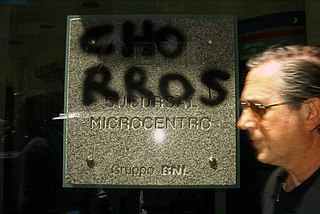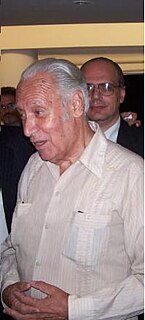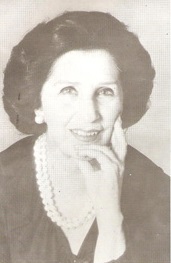Related Research Articles

Carlos Gardel was a French Argentine singer, songwriter, composer and actor, and the most prominent figure in the history of tango. Gardel's baritone voice and the dramatic phrasing of his lyrics made miniature masterpieces of his hundreds of three-minute tango recordings. Together with lyricist and long-time collaborator Alfredo Le Pera, Gardel wrote several classic tangos.

Lunfardo is an argot originated and developed in the late 19th and early 20th centuries in the lower classes in Buenos Aires and from there spread to other cities nearby, such as the surrounding area Greater Buenos Aires, Rosario and Montevideo.

Buenos Aires is the capital and largest city of Argentina. The city is located on the western shore of the estuary of the Río de la Plata, on the South American continent's southeastern coast. "Buenos Aires" can be translated as "fair winds" or "good airs", but the former was the meaning intended by the founders in the 16th century, by the use of the original name "Real de Nuestra Señora Santa María del Buen Ayre", named after the Madonna of Bonaria in Sardinia. The Greater Buenos Aires conurbation, which also includes several Buenos Aires Province districts, constitutes the fourth-most populous metropolitan area in the Americas, with a population of around 15.6 million.

Juan Bautista Alberdi was an Argentine political theorist and diplomat. Although he lived most of his life in exile in Montevideo, Uruguay and in Chile, he influenced the content of the Constitution of Argentina of 1853.

Gaucho literature, also known as gauchesco ("gauchoesque") style was a literary movement purporting to use the language of the gauchos, comparable to the American cowboy, and reflecting their mentality. Although earlier works have been identified as gauchoesque, the movement particularly thrived from the 1870s to 1920s in Argentina, Uruguay and south of Brazil after which the movement petered out, although some works continued to be written. Gauchoesque works continue to be read and studied as a significant part of Argentine literary history.

Juan Gelman was an Argentine poet. He published more than twenty books of poetry between 1956 and his death in early 2014. He was a naturalized citizen of Mexico, country where he arrived as a political exile of the Military Junta.

Tita Merello was a prominent Argentine film actress, tango dancer and singer of the Golden Age of Argentine Cinema (1940–1960). In her 6 decades in Argentine entertainment, at the time of her death, she had filmed over thirty movies, premiered twenty plays, had nine television appearances, completed three radio series and had had countless appearances in print media. She was one of the singers who emerged in the 1920s along with Azucena Maizani, Libertad Lamarque, Ada Falcón, and Rosita Quiroga, who created the female voices of tango. She was primarily remembered for the songs "Se dice de mí" and "La milonga y yo".

China Zorrilla was an Uruguayan theater, film, and television actress, also director, producer and writer. An immensely popular star in the Rioplatense area, she is often regarded as a "Grand Dame" of the South American theater stage.
The Net Party was a political party headquartered in Argentina. The company proposes an online form of liquid democracy that it calls "net democracy" based on the Internet. Their goal is to elect representatives who will reliably vote according to what the citizenry decide online.
The 1970 Copa Libertadores de América was the 11th edition of CONMEBOL's top Association football club tournament. Estudiantes successfully defended their title for the second straight year by defeating Peñarol in the finals. Teams from Brazil did not participate in this year's tournament due to CBF still disagreeing with the format.

Argentina–Uruguay relations are foreign relations between the Argentine Republic and the Oriental Republic of Uruguay. Both countries were part of the Spanish Empire until the early 19th century.

The Cry of Asencio or Admirable alarm was an 1811 pronunciamiento that took place at the Banda Oriental against the Spanish rule in Montevideo. Made in support of Buenos Aires, which had already ousted the viceroy and established a local government during the May Revolution, it is considered the beginning of the Oriental revolution.

Carlos María Domínguez is an Argentine writer and journalist who lives in Montevideo since 1989.

Nina Miranda was an Uruguayan tango singer and composer who settled in Argentina in the early 1950s. She is known for the songs, "Maula", "Garufa", "Mamá, yo quiero un novio", "La tigra", and the popular "Fumando espero".

Alberto René Methol Ferré was a Uruguayan thinker, writer, journalist, teacher, historian and theologian. He has been described as one of Latin America's most fertile and original thinkers.

Víctor Hugo Morales Pérez is a Uruguayan journalist, pundit and writer who has lived and worked in Argentina since 1981. As a football commentator, he has been regarded as one of the best in the Spanish-speaking world. In Argentina his commentary on Diego Maradona's second goal in the 1986 World Cup quarter-final was widely praised.
Alas Uruguay was an airline from Uruguay. It was founded by former employees of the defunct Uruguayan flag carrier, PLUNA, which closed in 2012. PLUNA had been a state-owned enterprise most of its life, and a mixed-ownership enterprise in later years, but Alas Uruguay was started as a private company, owned and managed by its own workers. Its bases were Carrasco International Airport in Montevideo and Capitán de Corbeta Carlos A. Curbelo International Airport in Punta del Este. The company first adopted the name Alas-U, but in October 2013 was renamed Alas Uruguay. It started operations in January 2016 but, mired in debt, it stopped flying in October the same year and was eventually declared bankrupt.

Cecilio Pablo Fernando Podestá was a Uruguayan-Argentine stage actor, singer, acrobat, sculptor and painter. He is considered to be one of the most prominent actors of classical Argentina theatre, and along with his brothers, was one of the founders of the Circo criollo. A number of institutions and places are named after him, including a town in Buenos Aires Province, and film awards known as the Premios Pablo Podestá.

Guma Zorrilla de San Martín Muñoz was a Uruguayan costume designer for theater, film, and television.
Agó Páez is a Uruguayan plastic artist. Her work focuses on mandalas and the philosophy that supports them.
References
- ↑ "Tarik Carson, un escritor de raza" (in Spanish). Retrieved 21 August 2019.
- ↑ "El retorno de un raro". La Diaria (in Spanish). 28 January 2011. Retrieved 21 August 2019.
| This article about a Uruguayan writer or poet is a stub. You can help Wikipedia by expanding it. |
| This article about a Uruguayan painter is a stub. You can help Wikipedia by expanding it. |